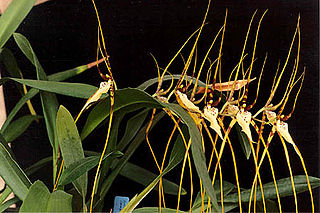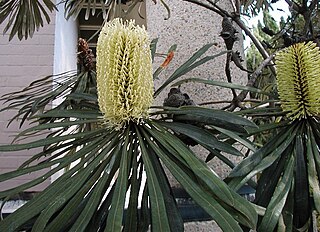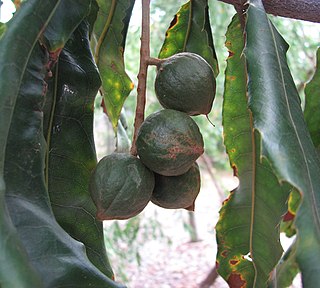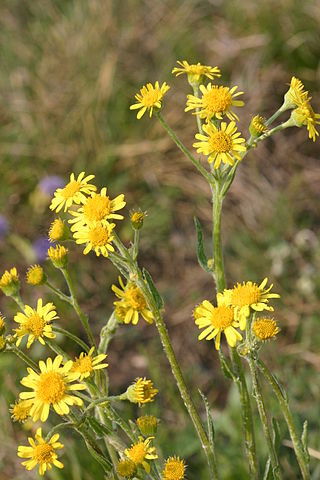
Banksia is a genus of around 170 species in the plant family Proteaceae. These Australian wildflowers and popular garden plants are easily recognised by their characteristic flower spikes, and woody fruiting "cones" and heads. Banksias range in size from prostrate woody shrubs to trees up to 30 metres (100 ft) tall. They are found in a wide variety of landscapes: sclerophyll forest, (occasionally) rainforest, shrubland, and some more arid landscapes, though not in Australia's deserts.

Phragmipedium is a genus of the Orchid family (Orchidaceae) and the only genus comprised in the tribe Phragmipedieae and subtribe Phragmipediinae. The name of the genus is derived from the Greek phragma, which means "division", and pedium, which means "slipper". It is abbreviated 'Phrag' in trade journals.

Stanhopea is a genus of the orchid family (Orchidaceae) from Central and South America. The abbreviation used in horticultural trade is Stan. The genus is named for the 4th Earl of Stanhope (1781-1855), president of the Medico-Botanical Society of London (1829-1837). It comprises 55 species and 5 natural hybrids. These epiphytic, but occasionally terrestrial orchids can be found in damp forests from Mexico to Trinidad to NW Argentina. Their ovate pseudobulbs carry from the top one long, plicate, elliptic leaf.

The genus Pulsatilla contains about 40 species of herbaceous perennial plants native to meadows and prairies of North America, Europe, and Asia. Derived from the Hebrew word for Passover, "pasakh", the common name pasque flower refers to the Easter (Passover) flowering period, in the spring. Common names include pasque flower, wind flower, prairie crocus, Easter flower, and meadow anemone. Several species are valued ornamentals because of their finely-dissected leaves, solitary bell-shaped flowers, and plumed seed heads. The showy part of the flower consists of sepals, not petals.

Brassia is a genus of orchids classified in the subtribe Oncidiinae. It is native to Mexico, Central America, the West Indies, and northern South America, with one species extending into Florida.

Odontoglossum, first named in 1816 by Karl Sigismund Kunth, is a genus of about 100 orchids. The scientific name is derived from the Greek words odon (tooth) and glossa (tongue), referring to the two tooth-like calluses on the base of the lip. This genus of cool to cold growing orchids is to be found on open spots in the humid cloud forest at higher elevations from Central- and West South America to Guyana, with most species around the northern Andes. The abbreviation for this genus is Odm. in the horticultural trade.

South Stack Cliffs RSPB reserve is a nature reserve, run by the RSPB, on Holy Island on the North West coast of Anglesey, Wales. The reserve is on sea cliffs facing the islet of South Stack, and is crossed by the Anglesey Coastal Path. There is an information centre based in Elin's Tower in the reserve.

Banksia integrifolia, commonly known as the coast banksia, is a species of tree that grows along the east coast of Australia. One of the most widely distributed Banksia species, it occurs between Victoria and Central Queensland in a broad range of habitats, from coastal dunes to mountains. It is highly variable in form, but is most often encountered as a tree up to 25 metres (82 ft) in height. Its leaves have dark green upper surfaces and white undersides, a contrast that can be striking on windy days.

Rhus integrifolia, also known as lemonade sumac, lemonade berry, or lemonadeberry, is a shrub to small tree. It is native to the Transverse and Peninsular Ranges and the South Coast regions of Southern California. This extends from Santa Barbara County and the Channel Islands to San Diego County and extending into north-central Pacific coastal Baja California and its offshore islands such as Cedros Island.

Banksia aquilonia, commonly known as the northern banksia and jingana, is a tree in the family Proteaceae and is endemic to north Queensland on Australia's northeastern coastline. With an average height of 8 m (26 ft), it has narrow glossy green leaves up to 20 cm (7.9 in) long and 6 to 10 cm high pale yellow flower spikes, known as inflorescences, appearing in autumn. As the spikes age, their flowers fall off and they develop up to 50 follicles, each of which contains two seeds.

Banksia integrifolia subsp. monticola, commonly known as White Mountain banksia, is a subspecies of Banksia integrifolia. Described in 1994, it occurs in the Blue Mountains and in northern New South Wales. It contains the largest recorded Banksia trees.

Banksia subg. Spathulatae is a valid botanic name for a subgenus of Banksia. It was published in 2007 by Austin Mast and Kevin Thiele, and defined as containing all those Banksia species having spathulate (spoon-shaped) cotyledons. The name was published to accommodate forthcoming changes to the taxonomic arrangement of Banksia, based on the DNA sequence analyses of Austin Mast and others, which suggested a phylogeny for Banksia very greatly different from the accepted taxonomic arrangement. They found Banksia to be paraphyletic with respect to Dryandra, and that these two genera were best split into two clades, one with beaked follicles and non-spathulate cotyledons, the other with unbeaked follicles and spathulate cotyledons. Initially this clade was informally named "/Cryptostomata", in reference to the stomates, which are sunken with constricted entrances. Accordingly, in 2007 Mast and Thiele initiated a rearrangement by transferring Dryandra to Banksia, and publishing B. subg. Spathulatae for the species having spathulate cotyledons. The type species of Spathulatae was given as B. integrifolia, but no further details have been given. Mast and Thiele have foreshadowed publishing a full arrangement once DNA sampling of Dryandra is complete.

Macadamia tetraphylla is a tree in the family Proteaceae, native to southern Queensland and northern New South Wales in Australia. Common names include macadamia nut, bauple nut, prickly macadamia, Queensland nut, rough-shelled bush nut and rough-shelled Queensland nut.

Macadamia integrifolia is a small to medium-sized tree, growing to 15 metres in height. Native to rainforests in south east Queensland and northern New South Wales, Australia. Common names include macadamia, smooth-shelled macadamia, bush nut, Queensland nut, Bauple nut and nut oak.

Tephroseris palustris, also known by its common names swamp ragwort, northern swamp groundsel, marsh fleabane, marsh fleawort, clustered marsh ragwort and mastodon flower, a herbaceous species of the family Asteraceae. It can be seen most easily when its bright yellow umbel flowers appear from May to early July standing 3 to 4 feet along marshes, stream banks and slough areas where it likes to grow.

Tephroseris is a genus of Eurasian and North American plants in the groundsel tribe within the daisy family.

Grevillea integrifolia, commonly known as entire-leaved grevillea, is a species of flowering plant in the family Proteaceae and is endemic to the south-west of Western Australia. It is an erect shrub with egg-shaped leaves, the narrower end towards the base, and cylindrical clusters of white to creamy-white flowers.

Pitstone Hill is a 22.9-hectare (57-acre) biological Site of Special Scientific Importance east of Pitstone in Buckinghamshire. It is in the Chilterns Area of Outstanding Natural Beauty, and is crossed by the Ridgeway National Trail.

Tephroseris integrifolia is a species of flowering plant belonging to the family Asteraceae.



















